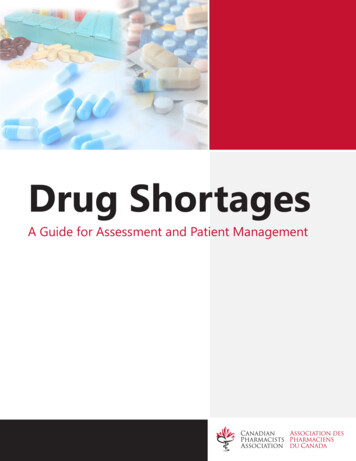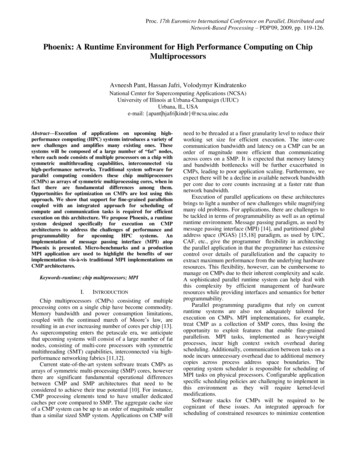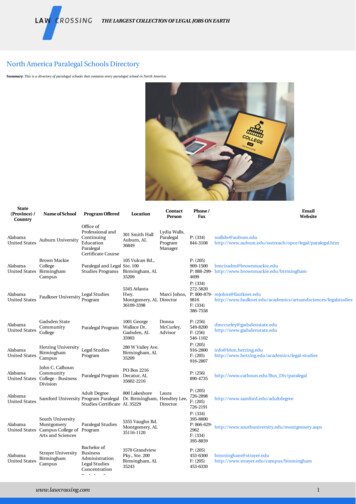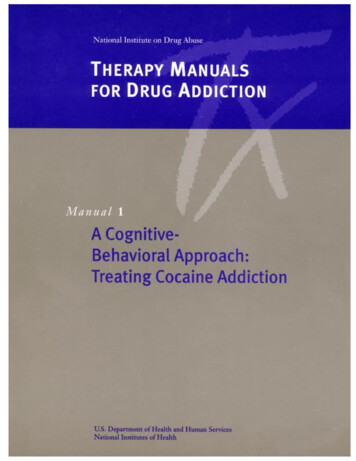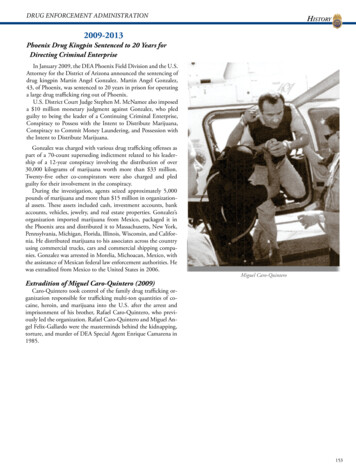
Transcription
DRUG ENFORCEMENT ADMINISTRATIONHistory2009-2013Phoenix Drug Kingpin Sentenced to 20 Years forDirecting Criminal EnterpriseIn January 2009, the DEA Phoenix Field Division and the U.S.Attorney for the District of Arizona announced the sentencing ofdrug kingpin Martin Angel Gonzalez. Martin Angel Gonzalez,43, of Phoenix, was sentenced to 20 years in prison for operatinga large drug trafficking ring out of Phoenix.U.S. District Court Judge Stephen M. McNamee also imposeda 10 million monetary judgment against Gonzalez, who pledguilty to being the leader of a Continuing Criminal Enterprise,Conspiracy to Possess with the Intent to Distribute Marijuana,Conspiracy to Commit Money Laundering, and Possession withthe Intent to Distribute Marijuana.Gonzalez was charged with various drug trafficking offenses aspart of a 70-count superseding indictment related to his leader ship of a 12-year conspiracy involving the distribution of over30,000 kilograms of marijuana worth more than 33 million.Twenty-five other co-conspirators were also charged and pledguilty for their involvement in the conspiracy.During the investigation, agents seized approximately 5,000pounds of marijuana and more than 15 million in organization al assets. These assets included cash, investment accounts, bankaccounts, vehicles, jewelry, and real estate properties. Gonzalez’sorganization imported marijuana from Mexico, packaged it inthe Phoenix area and distributed it to Massachusetts, New York,Pennsylvania, Michigan, Florida, Illinois, Wisconsin, and Califor nia. He distributed marijuana to his associates across the countryusing commercial trucks, cars and commercial shipping compa nies. Gonzalez was arrested in Morelia, Michoacan, Mexico, withthe assistance of Mexican federal law enforcement authorities. Hewas extradited from Mexico to the United States in 2006.Miguel Caro-QuinteroExtradition of Miguel Caro-Quintero (2009)Caro-Quintero took control of the family drug trafficking or ganization responsible for trafficking multi-ton quantities of co caine, heroin, and marijuana into the U.S. after the arrest andimprisonment of his brother, Rafael Caro-Quintero, who previ ously led the organization. Rafael Caro-Quintero and Miguel An gel Felix-Gallardo were the masterminds behind the kidnapping,torture, and murder of DEA Special Agent Enrique Camarena in1985.153
HistoryFederal and Local Law EnforcementWorking Together in ConnecticutIn February 2009, the DEA Bridgeport,Connecticut Resident Office (BRO) receiveda call from the Danbury Police Departmentfollowing the discovery of the body of Ed ward Rivera in a remote area of Danbury, CT.The BRO responded to Danbury and assistedwith the investigation. As a result of the inves tigation by DEA, the Danbury Police Depart ment, and the U.S. Marshal Service, it wasdiscovered that Rivera had been kidnappedfrom his address in Bronx, NY, robbed of 68pounds of marijuana, murdered, and driven60 miles to Danbury, where his body wasdumped in a wooded area. The vehicle usedto transport Rivera was found at a salvageyard in the Bronx.On March 1, 2009, the stolen marijuanawas recovered in a wall trap in the bedroomof defendant Andrew Zayac. Zayac was laterconvicted of the murder, kidnapping, androbbery of Rivera in federal court. Zayac’s co-defendant, Heriber to Gonzalez, was convicted on drug charges, tampering with evi dence, and obstruction of justice. From phone records obtainedduring the investigation, a connection was made to a marijuanaand steroid trafficking group in Danbury. A Title III investigationwas initiated with ties to the Bonnano Organized Crime Familyand the Hell’s Angels Motorcycle Club. The operation resultedin 12 federal arrests and the seizure of 200 pounds of marijuana,large quantities of steroids, and cash, vehicles, and real propertytotaling 750,000.00.United States Reaches 1 Million Settlement withKino Hospital in TucsonThe DEA Tucson District Office announced a settlement withKino Hospital in Tucson, AZ in March 2009 stemming from anaudit and an investigation conducted after doses of controlledsubstances were discovered missing from the hospital in early2004. Kino Hospital committed to fund 1,000,000 over fiveyears to establish a three-prong drug abuse prevention initiative tobenefit the Tucson area community.One part of the campaign was designed to educate parents andteachers of teenage students in southern Arizona on the signs andsymptoms associated with the abuse of prescription drugs. Theeducation campaign was developed and implemented in southernArizona middle schools and high schools by the Pima CountyDepartment of Health.The second initiative financed by Pima County was for thedevelopment and operation of an arrestee drug usage data col lection program. This program allowed Pima County to tracktrends in drug usage, providing data to aid in assessing the vi ability of treatment efforts, law enforcement tactics, and generalcrime analysis.The final of the three programs was for the development andoperation of a drug treatment program to be implemented withinthe Pima County jail system. The purpose of this program wasto provide immediate access to drug treatment for Pima Countyinmates on a voluntary basis.154Operation Blade RunnerOperation Blade Runner (2009)A traffic stop conducted by the Utah Highway Patrol in SaltLake City in February 2009 resulted in the seizure of 83 kilo grams of cocaine. Law enforcement determined the cocaine wasdestined for a location in eastern Washington, where it was tohave been loaded onto a helicopter in exchange for a load ofB.C. bud marijuana. When the helicopter touched down out side of Lone, Washington, DEA was waiting. Samuel LindseyBrown, 24, of Revelstoke, British Columbia, was arrested afterhe attempted to off-load 12 large duffel bags containing 426pounds of marijuana. During the course of the investigation, aDEA Special Agent working undercover infiltrated the organi zation and arranged to receive 300 pounds of B.C. bud mari juana and to deliver 20 kilograms of cocaine to be smuggledinto Canada.On March 5, 2009, the group attempted the exchange withthe undercover DEA Special Agent using a helicopter in NorthIdaho. A Kelowna, British Columbia man landed the helicopterin Northern Idaho and was arrested after unloading 174 poundsof B.C. bud marijuana.Through information sharing between the U.S. and Canada,the Royal Canadian Mounted Police (RCMP) identified the land ing site in Canada. The RCMP arrested two men from Chilli wack, B.C. and seized 150 pounds of marijuana and approxi mately 40,000 ecstasy pills. Additional search warrants served inNelson, Salmon Arm and Malakwa, B.C. resulted in the seizure ofsix guns and two arrests. Together, DEA and the RCMP arrestednine subjects and seized over 750 pounds of marijuana, over 80kilograms of cocaine, six weapons, and two helicopters.4-Star General Accompanies DEAIn March 2009, General David McKiernan, the U.S. Com mander of all NATO and U.S. Forces in Afghanistan, accompa nied DEA agents on a search warrant execution near Jalalabad,Afghanistan. General McKiernan was the first 4-star General toaccompany DEA agents in the field in Afghanistan. DEA FASTand DEA Kabul Country Office agents executed the operation
Historyof his traditional operating zone. Ultimately,Alfonso Cano’s hideout was pinpointed andin the early morning hours of November 4,2011, the Colombian Air Force bombed thelocation while hundreds of elite ColombianArmy Special Forces troops descended fromhelicopters to surround the mountainsidehideout. Alfonso Cano was killed in actionas he tried to sneak through the Army Spe cial Forces security perimeter under coverof darkness dressed in civilian clothes. Thisevent marks the only time in Colombia’s 48 year fight against FARC that the SupremeCommander of the FARC was killed.Physician Accused of MultipleCrimes in Massive PrescriptionDrug CaseIn June 2009, the DEA Bogota Country Office Narco-Ter rorism Group began assisting the Cuerpo Tecnico de Investigations(CTI), the Colombian judicial investigative branch, and the Co lombian Army in their manhunt to capture indicted FARC Su preme Commander Guillermo Leon Saenz Vargas a.k.a. AlfonsoCano. Though he had been a DEA target for some time, it wasAlfonso Cano’s 2009 rise to the supreme leadership position, thatmade him DEA’s number one FARC target.For two years DEA and other U.S. Government agencies,along with elements of Colombian Military Intelligence, Co lombian Army Special Forces, CTI, and the Colombian Na tional Police pursued and targeted Alfonso Cano in a sustainedseries of intelligence driven military offensives. Dubbed Opera tion Odyssey, the offensive was designed to systematically attackAlfonso Cano’s security and logistical support to push him outIn July 2009, the DEA Phoenix Field Di vision and the Arizona Attorney General’sOffice announced the filing of felony chargesand the Maricopa County Superior Court’sissuance of a 10 million seizure warrant against a Nevada doc tor who allegedly wrote illegal drug prescriptions for patients ata clinic he operated in Mohave County. He also allegedly col lected 3.5 million in fraudulent insurance claims, including 2.5 million from the State of Arizona.The 14 felony counts against Dr. Albert Szu Sun Yeh, 44, of LasVegas, included conspiracy, assisting a criminal syndicate, moneylaundering and improperly administering narcotic drugs. In aseparate indictment, seven felony counts were filed against Dr.Yeh’s physician assistant, Bryan V. Espinosa, 54, of Henderson,Nevada.Dr. Yeh, who was licensed to practice in both Nevada and Ari zona, maintained a practice in Las Vegas and saw Arizona patientsonly on Tuesdays at his Pain Wellness Center in Golden Valley,Ariz., a town with a population of about 5,000 near Kingman. Hewould typically write more than 100 prescriptions each Tuesdaythe center was open. The warrant served during the operation ledto the seizure of 3.9 million in multiple bank accounts, invest ment accounts, real estate and other property belonging to Dr.Yeh.DEA SAC Elizabeth W. Kempshall with Arizona Police Chiefs.Dr. Yeh’s Pain Wellness Center in Arizona.General David McKeirnan with DEA ASAC Selby Smith, who organized General McKiernan’sparticipation on this operation.and seized 900 kilograms of morphine. General McKiernan be came a friend of DEA in Afghanistan and was instrumental inproviding military assistance for DEA operations.DEA Aids Colombians Against the FARC155
HistoryDEA remembers three fallen agents in Afghanistan.DEA Loses Three Heroes in the Line of DutyOn October 26, 2009, three DEA special agents and sevenU.S. military service members tragically lost their lives during op erations in western Afghanistan.During the early morning hours of Monday, October 26,2009, SAs Michael E. Weston, Forrest N. Leamon, Chad L. Mi chael, other DEA SAs, U.S. Special Forces, and Afghan militarycounterparts, were executing Afghan search warrants at a bazaarin Afghanistan’s rugged Badghis province. This bazaar was a safehaven for insurgents and contained significant quantities of nar cotics, improvised explosive devices, and weapons used againstCoalition Forces. This operation supported the Government ofAfghanistan’s Rule of Law efforts to disrupt the material supportof the Taliban by drug traffickers in western Afghanistan.After a successful counter narcotics/counter insurgency opera tion, (which included an hour-long firefight with insurgents), theDEA agents, U.S. military personnel, and Afghan counterpartswere departing the target area on a U.S. military helicopter whenit crashed, killing SA Weston, SA Leamon, SA Michael, and sevenU.S. Special Forces personnel.The crash also injured 26 other personnel, including DEAGroup Supervisor Patrick McDarby. GS McDarby received nu merous injuries during the incident but continued to assist withextracting injured personnel out of the crashed helicopter. All ofthe injured and deceased were recovered from the crash site andreturned to base.OCDETF Strike Force Opens in PhoenixOn October 1, 2009, Deputy Attorney General David W. Og den, along with U.S. Attorney Dennis K. Burke, Acting Directorof the Bureau of Alcohol, Tobacco and Firearms Kenneth Melson,Drug Enforcement Administration Deputy Chief of OperationsDave Gaddis, and other federal and local officials unveiled thenew Organized Crime Drug Enforcement Task Force (OCDETF)Strike Force site in Phoenix, AZ.156DEA Reopens Country Office in UzbekistanGiven the need to address the Afghan drug trade and Uzbeki stan’s increased efforts to address counter-narcotic issues, theGovernment of Uzbekistan accredited DEA special agents to theU.S. Mission in Tashkent, and in October 2009, DEA formallyre-opened the Tashkent Country Office.In recognition of this new era of bilateral cooperation, thenDEA Assistant Administrator and Chief of Intelligence, AnthonyPlacido, traveled to Tashkent, Uzbekistan to attend meetings withhigh-ranking Uzbek officials. Afterwards, U.S. Ambassador Rich ard Norland held a reception in honor of Mr. Placido’s visit. Dis tinguished Uzbek guests included the Chairman of the NationalSecurity Service, the Minister of the Interior, the Chairman of theState Customs Committee, the General Prosecutor, and the firstDeputy Foreign Minister.Operation Medicine Cabinet New JerseyOver 9,000 pounds of medicine, with a street value of over 35 million, was collected during Operation Medicine CabinetNew Jersey in November 2009. This was a first in the statewideday of disposal of unused, unwanted, and expired medicine. Thisstatewide effort was spearheaded by the DEA New Jersey Divi sion and the Partnership for a Drug Free New Jersey (PDFNJ)with support from many other local and statewide prevention andenforcement organizations.More than 440 local police departments and sheriff depart ments across all of New Jersey’s 21 counties hosted collection sites,where New Jersey residents came out in force to rid their homes ofunused, unwanted, and expired medicines.Operation Medicine Cabinet New Jersey accomplished twogoals—first and foremost, it generated unprecedented attentionto the issue of prescription and over-the-counter medicine abuse,and secondly, it caused tens of thousands of New Jersey residentsto look at their medicine cabinets as a potential source for youngpeople to access highly addictive and potentially deadly drugs.
HistoryOperation Medicine Cabinet New Jersey evolved into the nation wide program entitled National Take Back Initiative.Compton’s Prescription Drug DiversionInvestigationIn 2009, the DEA Oklahoma City Diversion Group receivedintelligence that a group of individuals were involved in traffickingoxycodone in Norman, OK. A prominent businessman, StephanCompton, his wife, their three sons and others were involved inthe drug trafficking activities. In October 2009, a wire interceptwas initiated on two of the Compton’s cellular telephone lines.As part of the scheme, the Comptons used others to acquireoxycodone tablets for them through scheduled doctors’ appoint ments where prescriptions were obtained. The individuals werepaid by the Comptons in exchange for the oxycodone tablets andwere even driven to their doctors appointments and pharmacies tofill the prescriptions. Once obtained, the oxycodone tablets werestored at various locations in Norman and Noble, OK.In December 2009, six search warrants were executed and42 individuals were arrested in a coordinated takedown of theComptons illegal pill distribution organization. As a result of theenforcement action, another investigation into the physicianswho supplied the Compton organization was immediately initi ated. In March 2012, in the U.S. District Court, Western Districtof Oklahoma, one of the main source physicians, Amar N. Bhan dary, was indicted on 53 counts of knowingly and intentionallydistributing and dispensing controlled substances. On April 26,2012, Bhandary was arrested in Frankfurt, Germany by Germanauthorities.DEA Detroit Takes Out Adarus Mazio BlackIn December 2009, DEA Detroit Field Division Task ForceGroup Eight concluded a five-year complex drug homicide in vestigation, which ended the reign of Adarus Mazio Black. Theinvestigation had begun in August 2004 after the bodies of twoMexican drug traffickers were found in a Detroit back alley. Itwas later determined the Mexican drug traffickers were killed atthe direction of Black after he became aware they were attempt ing to establish a competing cocaine and marijuana distributionnetwork in Detroit. In March 2005, Group Eight linked Blackto the murder of a federal government witness who was prepar ing to testify against Detroit-based drug dealers, including Black.The federal witness was shot in the head at point blank range ashe left his luxury car rental business. In May 2007, Group Eightlinked Black to the brutal slaying of two charter bus drivers whowere murdered before they could cooperate and speak about theirinvolvement in the seizure of 4.2 million in bulk currency linkedto Black. The bus drivers were shot multiple times in the headafter they were lured back to Detroit.Group Eight built a drug conspiracy and a CCE case againstBlack. On May 29, 2009, Black was convicted of conspiracy todistribute cocaine, conspiracy to distribute marijuana, continuinga criminal enterprise, escape, and obstruction of justice. On De cember 14, 2009, Black was sentenced to life in prison.They’re Guilty: Memphis Resident Office ConcludesRacketeering InvestigationCraig Petties was the head of a major Drug Trafficking Orga nization (DTO) based in Memphis, TN. The Petties DTO wasOn January 18, 2008, CPOT Craig Petties (left) arrived in Memphis viaDEA aircraft, escorted by Memphis RO TFO Therman Richardson (right).supplied with cocaine by CPOT Arturo Beltran-Leyva and hisassociate, Edgar “La Barbie” Valdez. The Petties DTO was anextremely violent organization that operated in the Memphisarea for several years and was responsible for at least five homi cides. The Petties DTO was also responsible for the importationof thousands of kilograms of cocaine over several years and waswidely regarded as the largest cocaine source of supply in theMemphis area. This violent organization was a major criminalenterprise with activities ranging from purchasing cocaine fromCPOT targets in Mexico, to street level trafficking in Memphisand elsewhere. Due to their connections with the Sinaloa Cartel,the prices the Petties organization paid for cocaine were far be low the amount paid by other groups in Memphis. This organi zation also provided weapons to the Beltran-Leyva organizationin Mexico.In January 2008, Petties was arrested in Queretaro, Mexicoby units of the Mexican military. All of the significant membersof this group were indicted in U.S. District Court in Memphis,with six members indicted in a Racketeering Influenced and Cor rupt Organization (RICO) case. In December of 2009, Pettiespled guilty to an indictment that included the RICO charge, fivecounts of violent crime in aid of racketeering activity and to sever al drug and money laundering charges. All members of the PettiesDTO pled guilty or were found guilty on various federal chargesin the Western District of Tennessee.Project CoronadoIn October 2009, DEA announced the successful culminationof Project Coronado, a 44-month multi-agency law enforcementinvestigation targeting the La Familia Michoacana drug cartel.The effort was the largest single U.S. strike against Mexican drugcartels to date. Over the course of two days, 303 individuals in 19states were arrested in a series of takedowns by federal, state, andlocal law enforcement. More than 3,000 agents and officers oper ated across the United States to make the arrests during the twoday takedown; 62 kilograms of cocaine, 729 pounds of metham phetamine, 967 pounds of marijuana, 144 weapons, 109 vehicles,and 2 clandestine drug labs were also seized.In total, Project Coronado led to the arrest more than 1,180individuals and the seizure of approximately 33 million in U.S.157
Historycurrency, 1,999 kilograms of cocaine, 2,730 pounds of metham phetamine, 29 pounds of heroin, 16,390 pounds of marijuana,389 weapons, 269 vehicles, and two clandestine drug labs. ThenDEA Acting Administrator Leonhart said at the culmination ofProject Coronado, “This organization, La Familia, the newest ofMexican cartels, is directly responsible for a vast majority of themethamphetamine pouring into our country across our South west Border, and has had a hand in fueling the cycle of violencethat is wracking Mexico today.”Operation Heavy CargoDEA Operation Heavy Cargo, which targeted a drug traffick ing organization using commercial aircraft to transport cocaine tothe United States, concluded in September 2009. This DTO be gan operating in or about 1999 and was responsible for smugglingover 19 million worth of cocaine into the United States. Theoperation revealed that employees of American Airlines wouldensure suitcases loaded with kilograms of cocaine were smuggledonto American Airlines aircraft and transported to different citiesin the U.S. Twenty-three airline employees were arrested in PuertoRico and Miami, with 18 million in property seized throughoutPuerto Rico.Operation XcelleratorOperation Xcellerator, which culminated in February 2009,targeted the very violent and dangerously powerful Sinaloadrug cartel and led to the arrest of more than 750 individu als on narcotics-related charges. More than 23 tons of narcot ics were seized as part of this 21-month multi-agency law en forcement investigation. Individuals indicted in the operationwere charged with a variety of crimes, including engaging in acontinuing criminal enterprise by violating various felony provi sions of the Controlled Substances Act, conspiracy to importcontrolled substances, money laundering, and possession of un registered firearms.Operation Xcellerator led to the arrest of 755 individuals andthe seizure of approximately 59.1 million in U.S. currency, morethan 12,000 kilograms of cocaine, more than 16,000 pounds ofmarijuana, more than 1,200 pounds of methamphetamine, morethan eight kilograms of heroin, approximately 1.3 million pills ofecstasy, more than 6.5 million in other assets, 149 vehicles, threeaircraft, three maritime vessels, and 169 weapons.Global Operation Targets Illegal Importation ofPharmaceuticalsIn November 2009, DEA, along with the National Intellec tual Property Rights Coordination Center, part of U.S. Immigra tion and Customs Enforcement, coordinated the involvement ofagents and officers from DEA, ICE, the U.S. Customs and Bor der Protection, the Food and Drug Administration, and the U.S.Postal Inspection Service and arrested numerous suspects involvedin Internet sale of counterfeit and illicit medicines.Agents and officers targeted over 7,000 suspect packages atinternational mail centers resulting in 724 packages being de tained for further examination and seizure. In addition to theseexaminations, the FDA issued 22 warning letters about illegalactivity occurring on 136 independent websites. To date, 90 ofthose websites or domain names have been permanently sus pended.158DEA Announces Arrest of Top La Familia CartelMemberOn August 3, 2009, DEA announced the arrest of Miguel An gel Berraza Villa, a key member of La Familia Michoacana and oneof Mexico’s most ruthless and violent drug cartels. Mexican policehad detained Berraza, a.k.a. “La Troca” and Salomon FigueroaHarrison, a cartel associate, in Apatzingan, Michoacan, Mexico.La Troca was identified as a significant meth trafficker basedin Apatzingan, Michoacan. DEA and Mexican law enforcementofficials had identified him as the individual who took over thecartel duties after Arnoldo Rueda Medina, a.k.a. “La Minsa,” wasarrested in late July by the Secretaria de Seguridad Publica.New Rules Governing Internet Pharmacies Go IntoEffectIn April 2009, DEA released new regulations implementingthe Ryan Haight Online Pharmacy Consumer Protection Act of2008. These regulations helped to prevent the illegal diversionof powerful controlled substances by means of the Internet. TheRyan Haight Act, named for an 18-year-old who died after over dosing on a prescription painkiller he obtained on the Internetfrom a medical doctor he never saw, was enacted on October 15,2008 through the joint efforts of his mother, Francine Haight,and members of Congress, with the support of the DEA.The statute amended the Controlled Substances Act (CSA) byadding several new provisions: New definitions, such as “online pharmacy” and “deliver,distribute, or dispense by means of the Internet;” A requirement of at least one face-to-face patient medi cal evaluation prior to issuance of a controlled substanceprescription; Registration requirements for online pharmacies; Internet pharmacy website disclosure information re quirements; and Prescription reporting requirements for online pharma cies.Associate of International Arms Dealer Monzer AlKassar Found GuiltyOn March 18, 2009 Tareq Mousa Al Ghazi, 62, an associate ofinternational arms dealer Monzer Al Kassar, was found guilty ofcharges relating to a conspiracy to sell millions of dollars’ worthof weapons to the FARC—a designated foreign terrorist organiza tion—that would be used to kill U.S. officers and employees inColombia.Between February 2006 and June 2007, Al Ghazi and AlKassar agreed to sell thousands of machine guns, millions ofrounds of ammunition, rocket-propelled grenade launchers, andsurface-to-air missile systems to the FARC. During a series ofrecorded telephone calls, e-mails, and in-person meetings, AlGhazi and Al Kassar agreed to sell the weapons to two individu als who were in fact confidential sources working with DEA.The confidential sources represented that they were acquiringthese weapons for the FARC to use in attacks directed at U.S.helicopters in Colombia.DEA Launches New Educational Website for ParentsIn February 2009, DEA launched a new educational websitefor parents, www.GetSmartAboutDrugs.com. The website was
HistoryDEA Chiefs of Intelligencedeveloped as a resource for parents and caregivers tohelp them identify drug abuse, prevent children fromusing drugs, and find resources for substance abuseprevention. The site was designed to speak to parentsand caregivers of middle school, high school, and col lege-age children in an informative and non-technicalmanner.Acting Administrator Michele M. Leonhart stated,“DEA wants to share our knowledge about drugswith parents, teachers, and all those who care aboutkeeping our children safe. In this fight, information ispower, and DEA’s new website has current, accurate,and practical information about how to spot signs ofabuse, identify drugs and paraphernalia, and how totalk to teens about drugs. With just a few clicks par ents will be confident and ready to help their kids re sist drugs.”DEA Chiefs of Intelligence Testify onCapitol HillOver the past five years, DEA Chiefs of IntelligenceAnthony Placido and Rodney Benson had many op portunities to testify in front of the U.S. legislature,highlighting the fact that the DEA intelligence pro gram has been relied upon by U.S. lawmakers in combatting both domestic and foreign law enforcementissues. These numerous examples of being called onto testify for lawmakers included testimony by Chiefof Intelligence Placido on March 17, 2009 regard ing “Law Enforcement Responses to Mexican DrugCartels” as well as testimony by Chief of IntelligenceBenson on October 4, 2010 regarding “Is Merida An tiquated? Part Two: Updating U.S. Policy to CounterThreats of Insurgency and Narco-Terrorism.”Operation Vaqueros (2010)On April 27, 2010, the DEA Sierra Vista ResidentOffice along with other federal, state, and local of ficials, announced arrests and charges against a Mexi can drug trafficking organization responsible for moving at least40,000 pounds of marijuana through southern Arizona. The DTOemployed advanced counter-surveillance, ramp trucks to overcomevehicle barriers at the border, and hidden vehicle compartments.Methods of ConcealmentSeven federal wiretaps approved in the OCDETF investiga tion, dubbed Operation Vaqueros for the “Cowboy” attire wornby members of the DTO, were unsealed by order of the U.S. Dis trict Court. Twelve people were indicted on federal conspiracy159
Historycharges. In the course of the investigation, 26people were indicted on federal charges, and13 on state charges.The 36-month investigation yielded 39state and federal indictments, and 34 ar rests, including one employee of the CochiseCounty Attorney’s Office who was arrestedon state charges for providing confidentialinformation to one of the drug traffickers inexchange for money. The remaining 27 de fendants were load drivers for the traffickingorganization and were prosecuted for drugtrafficking charges in federal and state courts.Baltimore’s Black Guerilla FamilyBetween April 2008 and July 2010, mem bers of DEA Baltimore District Office Group57, the office’s Special Investigations Group,joined with the Baltimore Police Depart ment, the Maryland Division of Corrections,the U.S. Attorney’s Office for the District ofMaryland and the Baltimore City Attorney’sOffice to attack a violent nationwide prisongang known as the Black Guerilla Family(BGF). BGF conducted its affairs through a pattern of criminalactivity including narcotics trafficking, robbery, extortion, bribery,retaliation against a witness or informant, money laundering, andcommercial robbery. BGF members used violence and threats ofviolence to coerce incarcerated persons to pay protection moneyto BGF, to enforce the BGF code of conduct, and to increase theircontrol of the Baltimore City drug trade and the underground“prison economy” throughout Maryland correctional facilities.Group 57 linked the drug trafficking activity of this violentprison gang to the international CPOT organization of BeltranLeyva during DEA’s Operation X
drug kingpin Martin Angel Gonzalez. Martin Angel Gonzalez, 43, of Phoenix, was sentenced to 20 years in prison for operating a large drug traicking ring out of Phoenix. U.S. District Court Judge Stephen M. McNamee also imposed a 10 million monetary judgment against Gonzalez, who pled guilty



